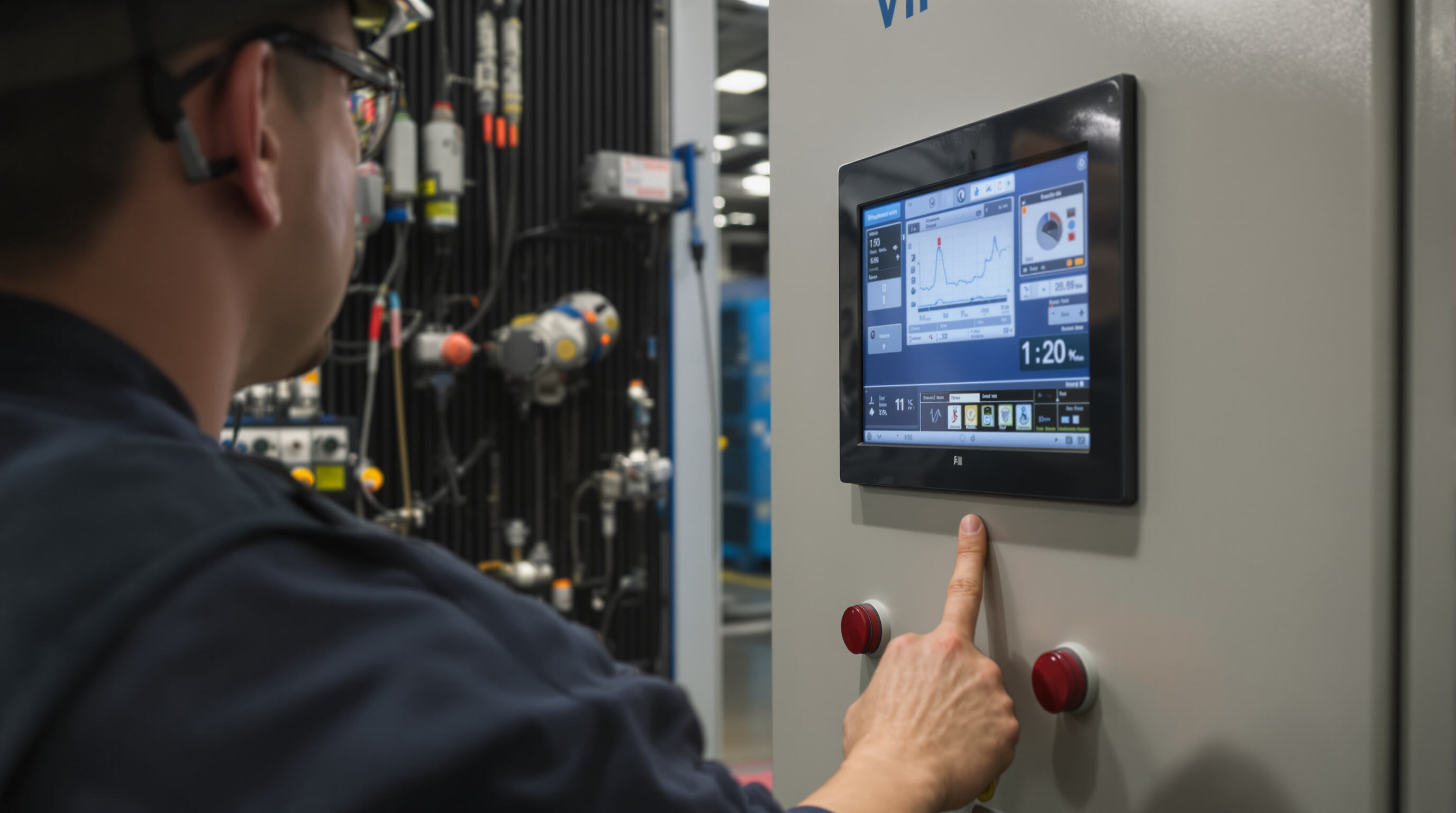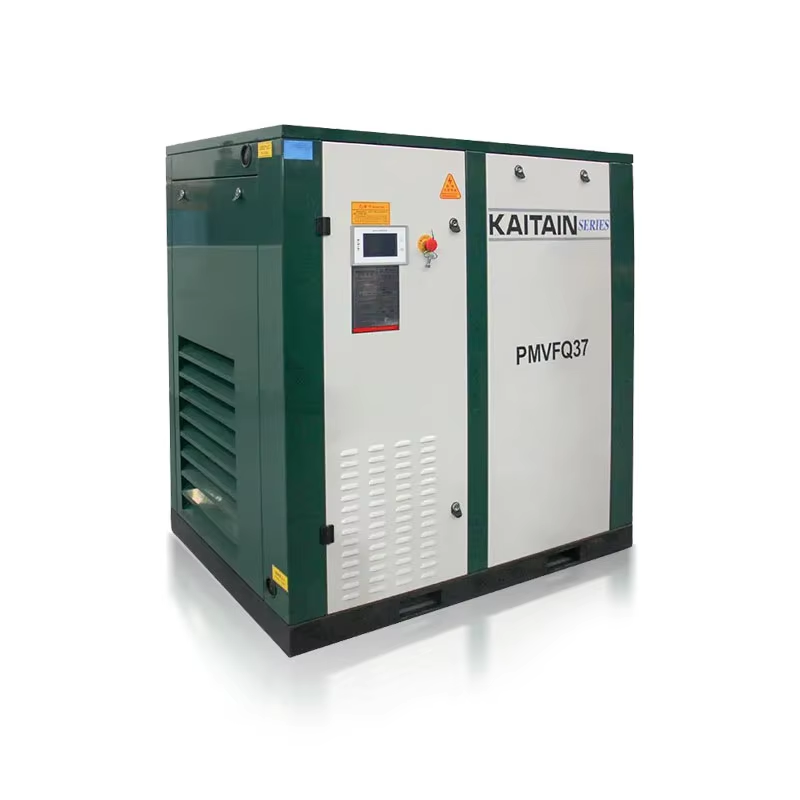Core Components and Build Quality of a Screw Air Compressor
Key Components of a Rotary Screw Air Compressor (Air-End, Motor, Cooling System)
Industrial screw air compressors really depend on three main parts working together: the air end, motor, and cooling system. Inside the air end, those specially made helical rotors mesh continuously to squeeze air down, which means we get steady airflow out the other end. When looking at motors for these machines, most industrial ones fall somewhere between 15 kW all the way up to 350 kW depending on what kind of work they need to do day after day. And let's not forget about the cooling system either. Without proper temperature control during long runs, things start breaking down faster than they should be. Good cooling keeps everything running smoothly without losing power or wearing out components prematurely.
The Role of the Air-End in Performance and Longevity
How well a screw compressor works and how long it lasts really depends on three main factors: the shape of the rotors in the air end, what materials they're made from, and how precisely they were machined. When manufacturers go for cast iron rotors or add nickel plating along with those special asymmetric shapes, these compressors can actually run about 25% more efficiently than the basic models out there. That means less wasted energy overall. Keeping those rotor gaps as small as possible is super important too. Most experts suggest getting this maintenance done somewhere around 8,000 to 12,000 operating hours. Doing so helps maintain consistent pressure levels while making sure the whole system stays reliable for much longer periods between replacements.
Motor Efficiency and Integration With Variable-Speed Drives
These days, most modern screw compressors come with IE4 class premium efficiency motors working alongside variable speed drives (VSDs) so they can adjust their output based on what's actually needed. A recent report from the US Department of Energy back in 2023 showed something pretty interesting too. Facilities that had these VSD equipped systems were able to cut down their energy usage by around 32% when dealing with changing airflow requirements compared to older fixed speed models. When manufacturers get the pairing right between the motor and VSD, there are real advantages. No more those nasty power spikes during startup which puts less strain on the electrical grid overall. Plus, equipment lasts longer since there's less wear and tear, meaning maintenance bills stay lower in the long run for plant operators.
Cooling System Design and Thermal Management for Continuous Operation
Efficient thermal management is essential for 24/7 operation, dissipating heat generated during compression and from motor windings. Oil-injected or water-cooled two-stage systems maintain internal temperatures below 90°C (194°F), preserving lubricant integrity. Closed-loop designs with plate heat exchangers achieve 98% thermal efficiency, outperforming basic air-cooled setups by 35% in high-temperature environments.
Durability, Build Quality, and Safety Features Under Industrial Loads
The machines are built tough with heavy cast iron frames and special mounts that absorb vibrations, allowing them to run for well over 60 thousand hours even in tough industrial environments. Pressure vessels meet ASME standards and come with backup thermal shutdown systems that go above and beyond what ISO 1217 requires. The enclosures have an IP55 rating which means they keep out dust and moisture effectively. These units follow all the major air compression rules around the world, so operators know they'll perform safely and reliably when pushed to their maximum capacity.
Energy Efficiency and Total Cost of Ownership in Screw Air Compressors
Energy Efficiency in Industrial Screw Compressors and Lifecycle Savings
The U.S. Department of Energy reported back in 2023 that energy costs alone eat up around 80% of what companies spend on screw compressors throughout their entire lifespan. So when we talk about savings over time, efficiency really becomes king. Better built rotary screw compressors cut down on air leaks and excessive heat thanks to smart engineering work behind the scenes. Facilities that install units correctly sized for their needs and run them at standard pressure levels around 100 PSI typically see energy consumption drop between 18 to maybe even 22 percent. For average sized manufacturing plants, this translates into real money saved each year something like fifteen thousand dollars going into the bottom line instead of disappearing into utility bills.
Fixed-Speed vs. Variable-Speed Drive (VSD) Compressors: A Performance and Cost Comparison
Standard fixed speed compressors run at the same RPM all the time no matter what the actual demand is, which wastes quite a bit of energy when things are slow or idle. Variable speed drives (VSDs) work differently though. These systems actually change the motor speed based on how much air flow is needed right then and there. This cuts down on wasted running time and saves power overall. The upfront price tag for VSD units does tend to be around 15 to 25 percent more than regular models. But look at it this way many businesses find that their energy bills drop by somewhere between 30 and 50 percent when they need varying amounts of compressed air throughout the day. Take a food packaging facility that runs non stop for instance. We've seen cases where companies recouped the extra money spent on VSD technology within just over 18 months purely from cutting back on electricity costs.
How VSD and Advanced Controls Improve Energy Efficiency
Advanced VSD systems work with AI-driven controllers to anticipate demand cycles and adjust output proactively. By maintaining tight pressure bands (±1 PSI), these systems prevent over-compression—a major source of inefficiency. Leading manufacturers report 22–37% efficiency gains when combining VSD compressors with adaptive controls, especially in environments with shifting production schedules.
Real-World Data: Energy Savings From VSD Adoption in Manufacturing Plants
A 2023 analysis of automotive parts suppliers revealed that facilities using VSD screw compressors saved $740,000 in energy costs over five years compared to fixed-speed units. One site reduced its annual carbon emissions by 41 metric tons, equivalent to removing nine passenger vehicles from the road each year.
Trend: Shift Toward Service-Integrated and Energy-Optimized Procurement Models
More operators are adopting performance-based contracts, where suppliers guarantee kWh savings or face financial penalties. This model incentivizes energy-efficient design and transparent TCO reporting. Over 65% of industrial buyers now require ISO 50001-certified compressors, reflecting a growing emphasis on sustainability and operational accountability.
Oil-Injected vs. Oil-Free Compressors: Selecting the Right Type for Your Application
Choosing between oil-injected and oil-free screw compressors depends on application-specific requirements for cost, maintenance, and air purity. Each type offers distinct advantages and trade-offs that impact long-term reliability and product quality.
Types of Rotary Screw Air Compressors: Oil-Injected vs. Oil-Free
Oil-injected compressors use lubricating oil within the air-end to seal, cool, and lubricate the rotors during compression. Oil-free models eliminate oil from the compression chamber entirely, relying on specialized rotor coatings or alternative cooling methods to maintain performance without contamination risk.
Trade-Offs in Cost, Maintenance, and Air Quality Between Oil-Injected and Oil-Free Models
Oil-injected units typically cost 15–30% less upfront but require regular oil changes, filter replacements, and air quality monitoring. Oil-free compressors command a 40–60% price premium but eliminate oil-related maintenance. They also meet ISO 8573-1 Class 0 standards—ensuring less than 0.01 mg/m³ of oil content—making them essential for contamination-sensitive industries.
Industrial Use Cases and Application Suitability for Each Compressor Type
- Oil-injected: Ideal for automotive manufacturing, metal fabrication, and general workshops where minor oil carryover does not affect processes
- Oil-free: Required in pharmaceuticals, food and beverage production, and electronics manufacturing, where even trace oil can compromise safety or product integrity
Impact of Untreated Air on Downstream Equipment and Product Quality
When oil injected systems aren't properly maintained, they tend to let out oil mist that damages parts further down the line. The oil particles hanging around in the air really shorten how long pneumatic tools last before needing replacement, somewhere between 18% to 34% less time overall. And for food processing plants especially, this kind of contamination problem leads to massive headaches when products get recalled. One industry report showed companies typically lose about $740k each year because of these issues. That's why picking the correct compressor model matters so much. Combine that choice with good filters and regular upkeep, and businesses stand a better chance at avoiding costly problems while keeping their products safe and consistent across the board.
Control Systems and Smart Monitoring in Modern Screw Air Compressors

Advanced Control Systems for Optimizing Operational Efficiency
Today's screw compressors come equipped with microprocessor controllers that can tweak pressure settings, manage airflow, and control energy consumption on the fly. Studies from the industrial automation field show these smart systems cut down on wasted idle time anywhere between 15% to 30% when compared with older control methods. The real magic happens when these controllers look at usage patterns over time. They track things like when workers start their shifts or when there are those inevitable busy seasons. Using this data, the algorithms keep the system running at just the right pressure without overworking the machinery. This not only saves energy but also means less wear and tear on components that would otherwise break down sooner.
Integration With IIoT and Predictive Maintenance Platforms
The best equipment comes with built-in IoT sensors that track things like vibrations, temperatures, and oil conditions right now while the machine is running. These sensors send all this information to special software systems that can spot problems coming down the road. For instance, maintenance teams often catch issues with bearings wearing out or filters getting blocked anywhere from 50 to 200 hours before something actually breaks. A recent study by PwC back in 2023 showed just how effective this approach has become. Plants that switched to predictive maintenance saw about 40 percent fewer unexpected shutdowns compared to traditional methods. Plus, they managed to extend the time between services for those critical air end components by roughly 22 percent on average.
User Interface and Remote Monitoring Capabilities
Intuitive touchscreen interfaces display real-time metrics including kWh consumption, pressure stability, and moisture levels. Mobile apps allow remote adjustments and alert management. A 2024 survey of 120 manufacturing plants found that 68% reduced technician dispatch times by using centralized dashboards to prioritize maintenance alerts.
Are Smart Controls Worth the Premium for Small-Scale Operations?
For operations under 20 HP, basic VSD compressors often offer better ROI than full IIoT integration. However, small-batch producers in sensitive sectors—such as pharmaceuticals—benefit significantly from smart controls' air purity monitoring, which helps avoid costly contamination events averaging $740,000 per incident.
Matching Air Treatment Components to System Needs
| Component | Critical Metrics | Maintenance Insight |
|---|---|---|
| Aftercoolers | ΔT (Inlet vs. Outlet) | 15°C drop signals clogging |
| Dryers | Dew Point Consistency | ±2°C fluctuations = desiccant replacement |
| Filters | Pressure Differential | 2 psi increase = element change required |
Systems that integrate these sensors with compressor controls achieve 18% higher airflow consistency in pneumatic tool lines, based on ASME 2024 findings.
Sizing, Selection, and Maintenance for Long-Term Reliability
Sizing Screw Compressors Based on Demand Profiles and Peak Usage
Getting the right size begins with looking at how much compressed air is actually needed, both what's used regularly and during those busy periods when everything ramps up. When compressors are too small for the job, they end up running nonstop at maximum power which wears them out faster. A recent study on fluid systems found that about one third of all early breakdowns happen because the equipment wasn't sized properly in the first place. Before making any purchases, it's smart to install data loggers and track airflow patterns for somewhere between a week and two weeks. And if there's lots of fluctuation in demand throughout the day, variable speed drive screw compressors work wonders. These machines adjust their output based on what's actually happening in real time, so they don't have to keep stopping and starting which causes so much stress on the system components.
Selection Criteria for Industrial Screw Air Compressors: A Decision Matrix
When evaluating models, prioritize:
- Energy efficiency: Verify ISO 1217:2022 certified performance data
- Total cost: Include 5-year estimates for energy, maintenance, and repairs
- Serviceability: Units with quick-access panels reduce downtime by 18–25%
- Compatibility: Ensure pressure dew point and flow match downstream requirements
Maintenance Requirements and Ease of Service in Daily Operations
Routine oil changes (every 2,000–8,000 hours), air filter replacements, and drive belt inspections prevent 67% of unplanned outages. Choose compressors with tool-free access panels and support from factory-trained technicians. Well-maintained high-quality units retain 90% of their airflow efficiency after 10,000 hours of operation.
Case Study: Failure Rate Analysis of Low-Build vs. High-Build Quality Units
A 2023 lifecycle assessment of 200 industrial screw compressors found that low-build units required 2.3 times more annual repairs and exhibited a 41% faster decline in energy efficiency after five years. In contrast, high-build models with reinforced rotors and precision bearings achieved 98.6% uptime, demonstrating superior return on investment despite a 15–20% higher initial cost.
FAQ Section
What are the main components of a screw air compressor and why are they important?
A screw air compressor consists mainly of the air end, motor, and cooling system. These components collaborate to provide continuous airflow, motor efficiency, and temperature control, ensuring proper machine function and longevity.
How do variable speed drives contribute to the efficiency of screw compressors?
Variable speed drives adjust the motor speed in response to actual airflow needs, reducing energy wastage during low-demand periods and minimizing power spikes, ultimately extending equipment lifespan and decreasing energy costs.
What are the pros and cons of oil-injected vs. oil-free compressors?
Oil-injected compressors are more cost-efficient upfront but require regular maintenance due to oil use. Oil-free compressors, though more expensive, are maintenance-free concerning oil, providing cleaner air suitable for sensitive industries like pharmaceuticals and food processing.
Table of Contents
-
Core Components and Build Quality of a Screw Air Compressor
- Key Components of a Rotary Screw Air Compressor (Air-End, Motor, Cooling System)
- The Role of the Air-End in Performance and Longevity
- Motor Efficiency and Integration With Variable-Speed Drives
- Cooling System Design and Thermal Management for Continuous Operation
- Durability, Build Quality, and Safety Features Under Industrial Loads
-
Energy Efficiency and Total Cost of Ownership in Screw Air Compressors
- Energy Efficiency in Industrial Screw Compressors and Lifecycle Savings
- Fixed-Speed vs. Variable-Speed Drive (VSD) Compressors: A Performance and Cost Comparison
- How VSD and Advanced Controls Improve Energy Efficiency
- Real-World Data: Energy Savings From VSD Adoption in Manufacturing Plants
- Trend: Shift Toward Service-Integrated and Energy-Optimized Procurement Models
- Oil-Injected vs. Oil-Free Compressors: Selecting the Right Type for Your Application
- Control Systems and Smart Monitoring in Modern Screw Air Compressors
- Sizing, Selection, and Maintenance for Long-Term Reliability
- FAQ Section

